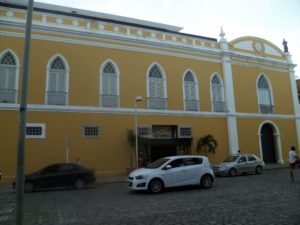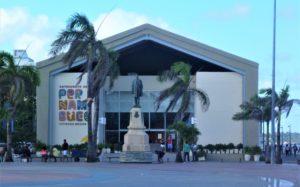The Downsides of Upgrading Tourist Destinations
Falina Enriquez
University of Wisconsin-Madison
Recife, the capital of the northeastern Brazilian state of Pernambuco, is well known among tourists for its annual musical events, like Carnival and the Festas Juninas (June Festivals), and proximity to UNESCO World Heritage sites, like Fernando de Noronha and the historic city of Olinda. However, despite these attractions and the metropolitan area’s integration into the global economy, Recife is frequented by few foreign tourists compared to other northeastern Brazilian cities like Salvador, Bahia (Revista Eventos 2013). As the influential Recife-based rock promoter, Paulo Andre Pires, put it in 2015, “the world has not yet discovered Pernambuco as a destination.” In the twenty-first century, governmental policies and commercial initiatives have sought to challenge Recife’s relative obscurity and draw more tourists to the area by revitalizing the city’s historic district of Recife Antigo (Old Recife), the small island where the city was founded in 1537 (fig.1).

When I began conducting ethnographic research about musical practices in the city in 2009, Recife Antigo was transforming from a mostly abandoned industrial port to an upscale cultural, touristic, and technological center. The cornerstone of the area’s development was the Porto Digital, a multinational software consortium that was partially funded through the privatization of the state’s energy company (Lyra 2016, Felipe 2016). Meanwhile, changes to Recife Antigo’s built environment highlighted the area’s palimpsestic character.

In 2001, an archaeological museum was constructed to monumentalize the first synagogue in the Americas, the Sinagoga Kahal Zur Israel, constructed in 1637 during a brief period of Dutch rule from 1630-1654. Visitors to the synagogue can see its original structures below its glass-paned first floor. Similarly, the Paço Alfândega, an upscale shopping mall built in 2002, was constructed out of the shell of a customs house that was initially a convent when it was erected in 1720 (fig.2)
However, during the early 2010s, these upgrades had not transformed Recife Antigo into an inclusive, consistently vibrant place. During the day, the district bustled with street vendors, office workers from the government agencies headquartered there, and shoppers going to the Paço Alfândega, the adjoining Livraria Cultura bookstore, and the weekly Sunday afternoon outdoor craft fair. However, as a primarily non-residential area, most of Recife Antigo’s cobblestone streets were relatively empty at night, especially during the weeknights. This emptiness, and the preponderance of muggings and drug trafficking, made Recife Antigo a place that many middle- and upper-class people avoided outside of Carnival and other seasonal festivals. On the other hand, Recife Antigo’s open plazas and lack of residents made it a hotspot for university students to gather to drink cheap beer and play loud music — from heavy metal to the drum-based Carnival genre, maracatu.

Nine years later, Recife Antigo’s built environment was visibly different. Previously empty warehouses were refurbished and occupied by cafes, bike shops, and pricey restaurants, including one specializing in ribs with a retro Anglophone rock n’ roll theme. Meanwhile, new structures were also built to develop the district into a museum campus, including the Cais do Sertão, a state-of-the-art multimedia museum focusing on regional music; the Paço do Frevo a museum of frevo, Recife’s most famous Carnival music; and a spacious, climate-controlled crafts mall called the Centro de Artesanato de Pernambuco (fig.3).
These new attractions, along with a corporate-sponsored bicycle rental system, were among the amenities enjoyed by international tourists arriving to Recife Antigo’s new cruise ship port. Although these changes have lent a glossy sheen to the previously dilapidated district, as in other cities (Abrahão and Gandara 2014), Recife Antigo’s transformation into a modern tourist destination involves relatively invisible forms of gatekeeping (see also Low 2011). Security guards posted at building entrances, high prices, and implicit dress codes keep working-class, racialized people from taking advantage of Recife Antigo’s upgrades. Moreover, new policies ostensibly related to safety limit the historic district to cosmopolitan tourists and well-off locals (see also Little 2014a & 2014b). As Eduardo Cardoso Gonçalves (2015) details, after several mass muggings and alleged “crimes against the patrimony” (76) in Recife Antigo, the Military Police implemented policies that ban adults without identification and unaccompanied minors from the area.
While access to Recife Antigo is unequal, infrastructural improvements in the district are also uneven. When I conduced my dissertation fieldwork in the city from 2010-2011, I witnessed the project to repaint the ornate nineteenth century Edifício Chantecler, assuming that it would be in use again soon. However, upon returning in 2014, 2015, and again in 2018, the building remains unused and has now been closed for decades despite several new coats of paint (Nascimento 2018). Similarly, while much of Recife Antigo has been either refurbished or built up, I noticed in 2018 that some of the western areas of the small island were neglected. For instance, a major street had a large hole filled with stagnant water that was surrounded by rubble to alert drivers of its presence (fig.4).

Recife Antigo has a lot to offer tourists interested in the city’s history and expressive culture. However, the forms of exclusion and infrastructural unevenness that have accompanied the historic district’s transformation during the past twenty years suggests that efforts to boost Recife’s tourism industry are superficial and therefore might not be sustainable in the long-term. As tourism scholars argue, in order to succeed in fomenting long-term economic growth, urban tourism development must be constructed not only with tourists in mind but also local communities and businesses (Abrahão and Gandara 2014; Molina 2005). While many of the key developments in Recife Antigo have been marketed as public improvements, the private organizations that manage them are not accountable to the public. For example, Porto Mídia, a new extension of the Porto Digital, is an incubator for small to mid-scale creative and cultural industry businesses that was funded by federal and state entities. Although Porto Mídia’s purpose is to make the creative economy more accessible and diverse, rather than serving the public, the organization is oriented around market logics that seek to distinguish Recife’s cultural industry within the global marketplace (Lima and Neto 2019; Marçal 2014).
Lastly, and sadly most ominously, it is not yet clear how Recife Antigo will be affected by the socioeconomic effects of the COVID-19 pandemic. The city’s tourism industry has been severely diminished, causing what a local newspaper described in 2020 as “desolation.” (Dourado 2020). Moreover in 2021, the Multicultural Carnival (O Carnaval Multicultural), the event that brings the most tourists to Recife Antigo, was temporarily canceled. Some local governmental agencies have sought to mitigate the economic effects of COVID-19 on workers in Recife’s tourism and cultural industries. In September 2020, Pernambuco’s Secretary of Tourism and Leisure (Secretaria de Turismo e Lazer de Pernambuco) held a virtual workshop to help tourism professionals to make better use of social media (Diário de Pernambuco 2020). Moreover, in 2021, Recife’s government established an Auxiliary Municipal Emergency fund (Auxílio Municipal Emergencial) to provide some financial relief to a segment of the cultural workers whose livelihoods have been rendered even more precarious by the pandemic (Prefeitura do Recife 2021).
However, as my spotlight on Recife Antigo suggests, these kinds of initiatives do little to address the uneven development and inequality that already characterize the local tourism industry. Ideally, rather than returning back to the status quo in the wake of the pandemic, government agencies—in collaboration with cultural and tourism workers and other citizens—should take advantage of this pivotal moment to change direction by implementing economic policies that directly involve and benefit the local working-class people who have largely been excluded from the tourism development that has shaped Recife Antigo during the last 20 years.